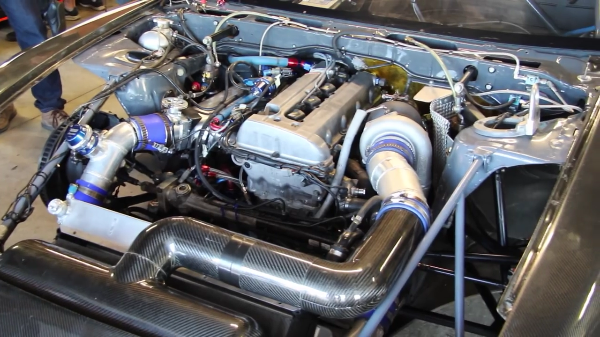The fabled Nissan engine has never been known to be a real monster of an engine; more of a plentiful, potent four-cylinder that has enough to do most things with. Well, this particular engine shows that getting the little four-banger to make nearly quad-digit power figures is a task in itself, but that’s only one part of the puzzle. The real challenge is delivering that power to the ground progressively and predictably – and we get tips from the team that built one so capable that it propelled a car to first place at World Time Attack this year.
The MCA Hammerhead, which is built from an S13 Silvia, has been after the WTAC gold for several years, but it’s last couple years have shown it to be a comprehensively well-built machine. It consists of a ported SR20VE head, a billet block, a methodically-chosen turbocharger, steel crank, pistons and con rods, a high-flow Hypertune manifold, and that’s about it. Notably, that billet block gives integrity to the deck surface and minimizes blowby. It staggering how an engine so small can make 880 horsepower on 40 pounds of boost, but the question is: how does it make that power usable? To beat the GT-Rs and Evos, which obviously have a traction advantage, they had to make sure the boost didn’t come on too abruptly nor too slowly.
 [1]
[1]“It’s all about being not wrong rather than being particularly special,” remarks Murray Coote on his selection of the right parts.
From an interview with MCA’s Murray Coote, getting the engine to produce a little more power to offset the increased drag they dealt with this year was step one. Step two involved making that power accessible, to which Coote remarked, “I think it’s important to be able to modulate throttle, rather than have to plan your day on a corner, and never change your mind.” In other words, having a flexible engine that allows for some mid-corner throttle modulation is always going to be more manageable.
This was done with a smaller, more responsive turbocharger and specific boost pressures depending on the gear to make it less prone for wheelspin, or torque-limited, as well as using specific boost-by-throttle position, to make it more progressive and manageable. Because the turbocharger is so good at making boost low down, it can be too responsive and make a “non-linear torque output,” so these measures were taken to make the car both responsive and progressive – two different things that are sometimes confused.
A smooth, constant throttle application is the way to get the most out of engine so that monstrous peak power figure can be accessed for as long as possible. Coote wisely adds, “The last thing you want to see in a throttle trace – in some data – is a lift-off on throttle at the exit of the corner.” He seems like the kind of wild-eyed, car-crazy uncle some of us have, whose wife tells him to avoid talking about cars at dinner parties. But, if his passionate rants can help smash the lap record by the margin this car has, we’re all ears.